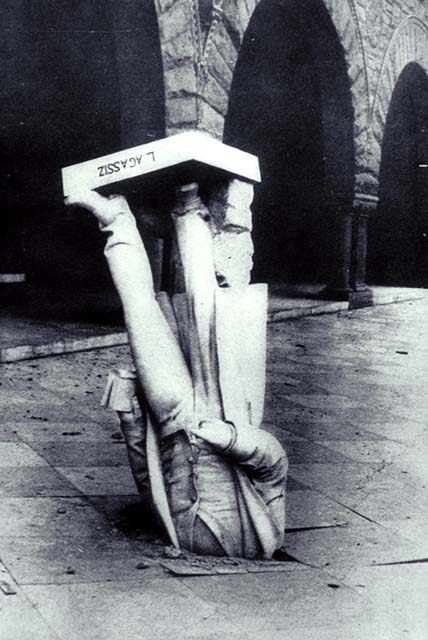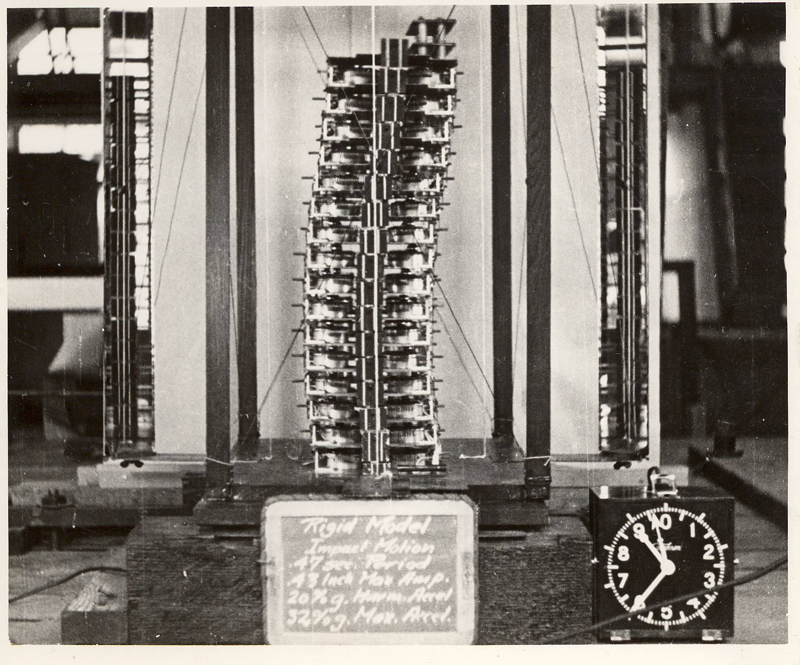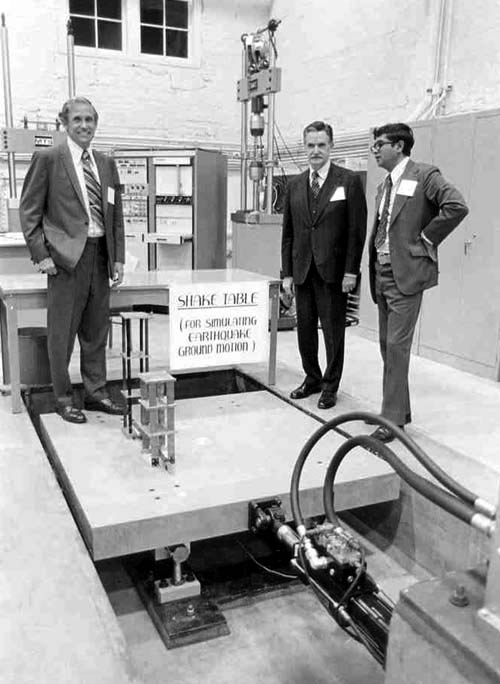You are hereThe History of the Blume Center
The History of the Blume Center
THE 1906 SAN FRANCISCO EARTHQUAKE
The destruction caused by the 1906 San Francisco earthquake marked the beginning of a long and rich history of research and innovation in engineering, seismology and geology at Stanford University. Most of the Stanford campus buildings were constructed of unreinforced masonry and were concentrated within a central quadrangle. Several buildings on campus were destroyed or severely damaged during the quake, including the newly built gymnasium, the library and museum, and Memorial Church. Colored mosaic tiles from the Memorial Church were later found several hundred meters from the collapsed structure.


Following that catastrophic event, Professor William Rogers developed the first instrument to experimentally investigate soil effects during earthquakes. Through the 1930s research continued, laying the foundation for many current analytical and design approaches, particularly through the work of Professor Bailey Willis following the 1925 Santa Barbara Earthquake, the same earthquake that inspired a young John Blume to enter the field of Earthquake Engineering.
In 1934 Professor Lydik Jacobsen and his student, John Blume, developed the first field instrument for strong shaking of structures and investigated the performance of several buildings. They created one of the earliest multi-dimensional building models and studied its performance on a shaking table. During the 1940s an impact table for simulating earthquake ground motions was used to study the mechanical performance of large shear walls, masonry structures, frames and other structural elements. These experiments were important for understanding building vibrations and the implications of dynamic performance on static design.


FOUNDING OF THE BLUME EARTHQUAKE ENGINEERING CENTER
In order to encourage the advancement of earthquake engineering research and education at Stanford, Dr. John A. Blume proposed the formation of the Earthquake Engineering Center that bears his name. Since its founding in 1974, the Blume Center has functioned as the umbrella for all earthquake engineering activities at Stanford University. The Blume Center has published more than one hundred technical reports and has organized major conferences, such as the Second US National Conference on Earthquake Engineering and the Fourth International Conference on Seismic Zonation. Researchers at the Blume Center have done pioneering work in many aspects of earthquake engineering, including seismic hazard and risk analysis, earthquake occurrence and ground motion modeling, component and system reliability, experimental research on small-scale models of structures and components, evaluation of damage potential of ground motions, and development of seismic design methodologies.


LOMA PRIETA EARTHQUAKE AND THE RETROFIT
In 1989 the Loma Prieta earthquake, a 7.1 magnitude quake centered in the Santa Cruz Mountains, caused a considerable amount of damage to buildings on the Stanford Campus, including Building 02-540, home to the John A. Blume Earthquake Engineering Center. Built in 1912, the building that now houses the Blume Center was originally an industrial engineering shop and aerodynamics lab, and has undergone significant changes over its lifetime. The building was constructed of lightly reinforced concrete piers and tie beams and unreinforced masonry infill with heavy wood timber trusses. It is considered to be a very important part of the University heritage and so every effort was made to preserve its original exterior appearance as well as all original construction material.

The seismic strengthening of the Blume Center, began in April of 1994, entailed improving the building to provide higher seismic strength, enhancing the building for disabled access, updating the fire suppression and detection system, and upgrading the building's telecommunications system. These concerns represent the needs and goals identified by Stanford University and required by Santa Clara County.
The connections between the high roof diaphragm (monitor) and roof trusses were strengthened to resist seismic forces. Bracing was added to the monitor side walls to transfer shear forces to the lower diaphragm. The lower roof diaphragm was strengthened by the addition of plywood sheathing. The ties between the lower roof diaphragm and walls were improved for shear and out-of-plane forces. New structural steel tubes were added as supplemental support for the existing roof trusses in the west portion, where they are supported by the existing concrete and masonry wall. Supplemental supports were not needed in the east portion where a substantial new shear wall provides lateral resistance and gravity load carrying capacity.
Lateral forces in the longitudinal (east-west) direction are resisted by concrete walls placed on the inside face of the existing walls. Lateral forces in the traverse (north-south) direction are resisted by the end walls and several interior steel braced frames.
The concrete and brick walls were also strengthened considerably. Around the entire perimeter of the building the brick infill above the window openings was removed and replaced with new concrete. On the north side of the building, the brick of three bays were removed leaving just the concrete piers. These bays were then infilled with concrete, creating a new concrete shear wall approximately 36 feet long. The new shear wall resists all of the seismic forces along the north side of the building. Interior steel braced frames were added to supplement the end walls as transverse lateral force-resisting elements. Braced frames were selected as the scheme best able to control building drift without undue adverse impact on functional use of the building. The steel braced frames are supported on new concrete grade beams, which in turn are supported by new drilled piers.
The renovation of the Blume Center is an architectural and structural engineering success story. The building maintains its historical appeal and architectural significance while completely restoring the structural integrity to meet current code requirements for earthquake load capacity. The programmatic enhancements to the building include new testing facilities, improved teaching and research computer clusters, and a modernized library. The new advanced technology laboratory is already being utilized for the development of new structural seismic sensors, and the testing of new materials is being planned for the future. Undergraduate students have been enjoying the new mechanics testing laboratory that houses innovative structural test equipment designed and built in our laboratory.
The Blume Center currently provides office space for over 60 graduate students, visiting scholars and professors, consulting faculty and NPDP (The National Performance of Dams Program). Our students research all aspects of Structural and Geomechnical Engineering. The John A. Blume Earthquake Engineering Center's mission is to continue to work to preserve the past and prepare for a seismically stable future.